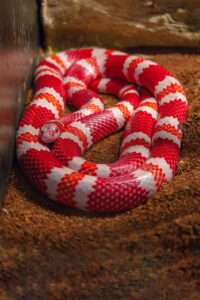Milk snake Care Guide
Published: February 12th, 2024
Identification and Appearance:
Milksnakes are distinguishable by their smooth scales, small rounded head, and lack of differentiation between the head and neck. Their color and pattern, varying by subspecies, often include bands of red/orange, black, and white/yellow.
Some may exhibit a saddle pattern with red/orange/brown and dark edges on a gray to cream base. In captivity, selective breeding results in diverse color morphs.
Size and Length Variation:
Milksnakes exhibit a wide range of lengths based on subspecies. Average lengths, sourced from “Kingsnakes and Milk Snakes” by Ronald G. Markel, vary, with examples like L. t. abnormal reaching 48-60″ (122-152cm) and L. t. triangulum ranging from 36-45″ (91-114cm).
Habitat and Range:
Primarily native to the United States, milksnakes are also found in some parts of southern Canada. Their adaptable nature allows them to inhabit various environments, including forests, rocky hillsides, swamps, prairies, farmlands, and sand dunes.
Popular as Pets:
Due to their vivid coloring, manageable size, hardiness, and tolerance for human interaction, milksnakes are among the most popular pet snakes in the United States. With proper care, they can live for 20 years or more.
Milksnake Shopping List:
For setting up a functional milksnake enclosure, a recommended shopping list includes items such as a suitable reptile enclosure, heating and lighting fixtures, substrates like Zoo Med Reptisoil or Eco Earth, environmental enrichment items, and a variety of feeding options.
Enclosure Size:
The recommended minimum enclosure size for an average milksnake is 48”L x 24”W x 24”H. Larger enclosures are preferable, especially for milksnake species known to grow beyond 48”/122cm long.
Multiple Housings and Social Behavior:
Milksnakes are not social animals, and housing them together poses risks, as they are known to be ophiophagus (snake-eaters). It is safest to house only one milksnake per enclosure.
Lighting and UVB:
Milksnakes, primarily active at night, do not require bright lighting. However, providing UVB lighting is beneficial for their health. Recommended bulbs include Zoo Med T5 HO Reptisun 5.0 or Arcadia T5 HO Forest 6%. Proper distances and placement should be considered for effective UVB exposure.
Download the Caresheet |
Multiple Housings and Social Behavior:
 Milksnakes are not social animals, and housing them together poses risks, as they are known to be ophiophagus (snake-eaters). It is safest to house only one milksnake per enclosure.
Milksnakes are not social animals, and housing them together poses risks, as they are known to be ophiophagus (snake-eaters). It is safest to house only one milksnake per enclosure.
Lighting and UVB:
Milksnakes, primarily active at night, do not require bright lighting. However, providing UVB lighting is beneficial for their health. Recommended bulbs include Zoo Med T5 HO Reptisun 5.0 or Arcadia T5 HO Forest 6%. Proper distances and placement should be considered for effective UVB exposure.
Temperature Requirements:
As cold-blooded animals, milksnakes regulate body temperature by moving between areas of different temperatures. Recommended temperature ranges include 85-90°F (29-32°C) for the basking surface, 75-80°F (23-27°C) on the cool side, and 70-75°F (21-23°C) at night.
Humidity Needs:
Maintaining an average humidity of 40-60% is essential for milksnakes. Providing a humid retreat, using methods like moistened sphagnum moss or substrate, helps achieve optimal humidity levels.
Substrate Options:
Milksnakes thrive on substrates that mimic their natural habitat. Options include Zoo Med Reptisoil, Eco Earth, Exo Terra Plantation Soil, Lugarti Natural Reptile Bedding, or a DIY mix of topsoil, Reptisoil, and play sand.
Feeding:
Being carnivores, milksnakes require a diet of whole animal prey. Feeding frequency varies by age, with hatchlings fed every 5-7 days, juveniles every 7-10 days, and adults every 10-14 days. Offering a diverse diet is crucial for their nutritional needs.
Handling:
Patience is key when handling milksnakes. Wait for the snake to settle in (approximately 2 weeks) and start with brief sessions, gradually increasing duration. Handling should occur at least weekly, once the snake is comfortable and eating regularly. Gentle handling, allowing the snake to crawl onto your hand, supports positive interactions.
Download the caresheet for Milk Snake |
Recent Posts
- All Post
- care sheets
- guide
- Lizards
- snakes
- Uncategorized
- Back
- Mourning Gecko
- Sandfish skink
- Tegu
- Ackie Monitor lifespan
- Bearded dragon
- Blue Tongue Skink
- Crested Gecko
- Gargoyle Gecko
- Jackson's Chameleon
- Leopard Gecko
- Back
- Ball Python
- Black Rat Snake
- Corn Snake
- Gila Monster
- kenyan sand boa
- Milk Snake
- Back
- lizardscs
- snakescs
Address
215 Woodland Ave. Manchester, NH 03102

